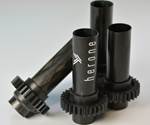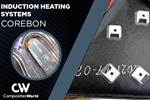Corebon, Composite Braiding partner to enhance TPC manufacturing
Collaboration aims to overcome production limitations with tubular thermoplastic composites (TPC) by using induction-heated tooling and high-quality commingled braids.
Corebon’s inducted-heated tooling and Composite Braiding’s high-quality thermoplastic braids enable the production of tubular composite parts at scale. Source | Corebon
Corebon (Malmö, Sweden) and Composite Braiding (Derby, U.K.) have announced a partnership to tackle production challenges in thermoplastic composites manufacturing. Together, the partners are addressing key issues engineers face with tubular thermoplastic composites — particularly the limitations caused by slow processes such as oil- or resistance-heated tools.
While isothermal processing is often used to avoid the thermal cycling of tools, it can restrict the design and production of complex composite parts, especially tubular structures. This collaboration seeks to eliminate those limitations by leveraging Corebon’s induction heated tooling technology alongside Composite Braiding’s high-quality commingled braids. The result is a robust and efficient manufacturing process, CorePlate, that enables the scalable production of composite components.
CorePlate, powered by Corebon’s frequency inverters is reported to offer fast, controlled heating cycles that significantly boost production efficiency. Combined with Composite Braiding’s thermoplastic braids, partners says that this approach makes it possible to manufacture complex tubular components at scale — parts that are difficult to achieve with traditional methods. Additionally, this variothermal process ensures a high-quality surface finish, essential for applications that demand both structural integrity and visual appeal.
Oscar Wiberg, CPO of Corebon, and Sam Donegani, operations manager at Composite Braiding, agree that this collaboration is a significant step forward for both companies. “The high rates and energy efficiency of our braiding process and Corebon’s heating technology offer huge energy savings (up to 99% versus more traditional options),” adds Donegani. “We’re excited about the potential to bring truly truly sustainable, high-volume, high-quality, affordable composites to new applications.”
Both Corebon and Composite Braiding are committed to further developing and expanding this technology, which has applications across a wide range of industries, including aerospace, automotive and consumer goods. Early trials have shown promising results, and the companies plan to demonstrate innovations at upcoming industry events.
Related Content
-
Plant tour: Albany Engineered Composites, Rochester, N.H., U.S.
Efficient, high-quality, well-controlled composites manufacturing at volume is the mantra for this 3D weaving specialist.
-
Plant tour: Joby Aviation, Marina, Calif., U.S.
As the advanced air mobility market begins to take shape, market leader Joby Aviation works to industrialize composites manufacturing for its first-generation, composites-intensive, all-electric air taxi.
-
PEEK vs. PEKK vs. PAEK and continuous compression molding
Suppliers of thermoplastics and carbon fiber chime in regarding PEEK vs. PEKK, and now PAEK, as well as in-situ consolidation — the supply chain for thermoplastic tape composites continues to evolve.
















